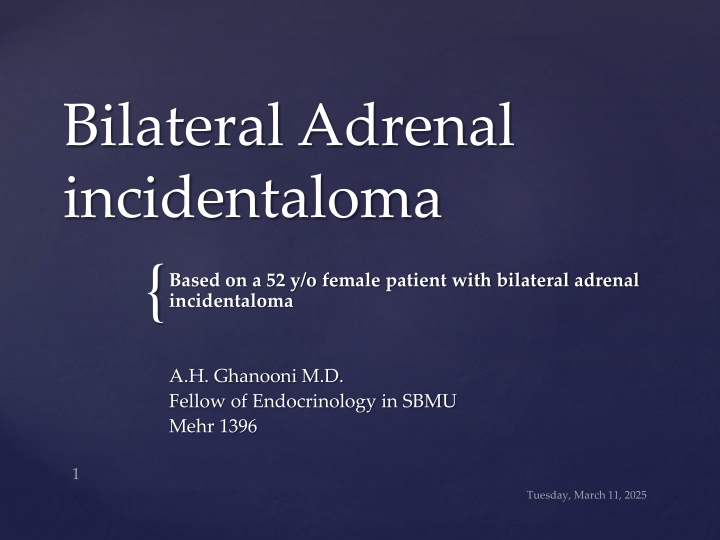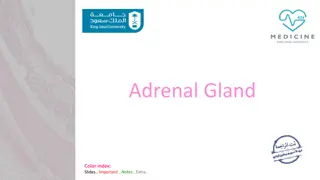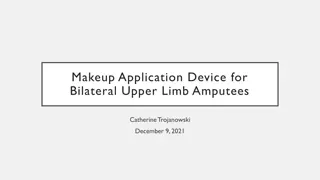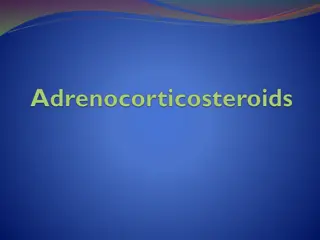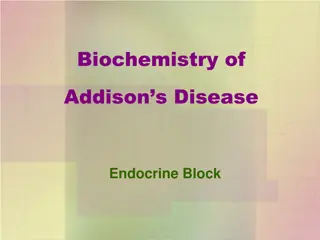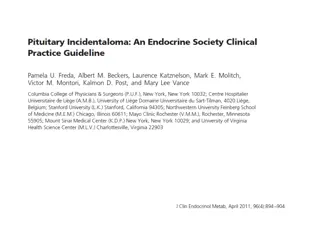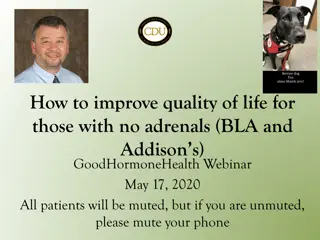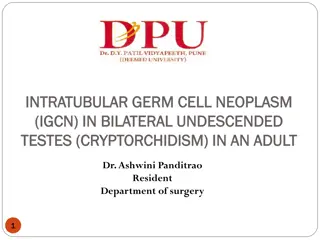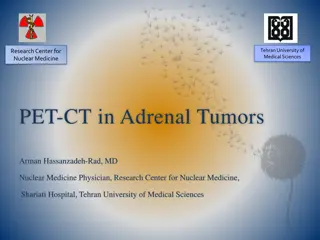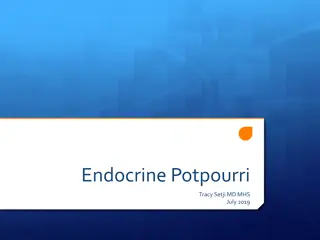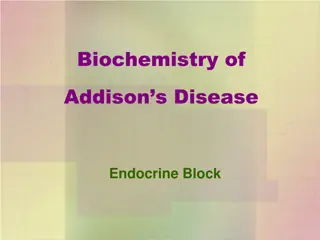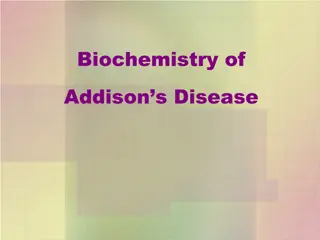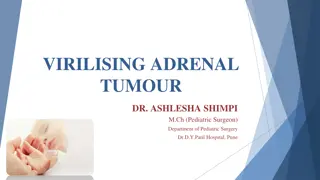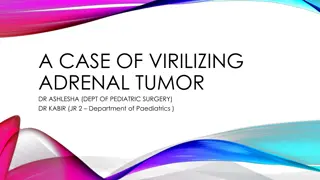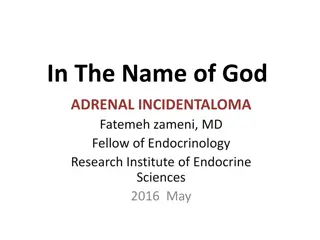Bilateral Adrenal incidentaloma
Bilateral adrenal incidentaloma refers to the detection of adrenal lesions unrelated to adrenal disease, commonly seen in imaging studies. Assessment involves determining benign or malignant nature, hormonal activity, and treatment decisions. Differentiation of various conditions affecting the adrenal glands is vital for appropriate management.
Download Presentation

Please find below an Image/Link to download the presentation.
The content on the website is provided AS IS for your information and personal use only. It may not be sold, licensed, or shared on other websites without obtaining consent from the author.If you encounter any issues during the download, it is possible that the publisher has removed the file from their server.
You are allowed to download the files provided on this website for personal or commercial use, subject to the condition that they are used lawfully. All files are the property of their respective owners.
The content on the website is provided AS IS for your information and personal use only. It may not be sold, licensed, or shared on other websites without obtaining consent from the author.
E N D
Presentation Transcript
Bilateral Adrenal incidentaloma { Based on a 52 y/o female patient with bilateral adrenal incidentaloma A.H. Ghanooni M.D. Fellow of Endocrinology in SBMU Mehr 1396
Adrenal incidentaloma refers to the casual detection of an adrenal lesion during imaging performed for reasons unrelated to adrenal disease. There is large consensus that this definition applies to adrenal nodules of at least 1 cm. In routine clinical practice, the prevalence of adrenal incidentaloma in upper abdominal CT scanning is around 1% in young individuals and higher in older individuals (i.e., 3% at 50 years of age and up to 15% after 70 years of age).
Assessment of the Patient with Adrenal Incidentaloma Three issues should be addressed upon detection of an adrenal incidentaloma : (1) establish whether the lesion is benign or malignant, (2) assess its hormonal activity, (3) decide upon treatment and follow-up
What type pattern of our patients adrenal incidentaloma was seen in imaging? Benign pattern but bilateral with special feature
Bilateral adrenal incidentaloma The differential for bilaterally enlarged adrenal glands is relatively limited: adrenal hyperplasia congenital adrenal hyperplasia macronodular adrenal hyperplasia ACTH-independent macronodular adrenocortical hyperplasia (AIMAH) adrenal metastases adrenal haemorrhage adrenal involvement with granulomatous diseases adrenal lymphoma primary pigmented nodular adrenal dysplasia (PPNAD): usually the glands are normal in size, but nodular. In older patients they may be enlarged 1. 2. 3. 4. 5. 6.
Adrenal hyperplasia Radiographic features enlarged limbs of one or both adrenal glands >10 mm thick normal adrenal morphology maintained nodular or uniform
ACTH-independent macronodular adrenocortical hyperplasia Radiographic features CT CT often characteristically shows massively enlarged multinodular adrenal glands. The nodules tend to vary in size ranging between 1 and 5.5 cm and are generally hypo- attenuating . There is also often distortion of the adrenal contour. MRI T1: generally hypointense compared with the liver T2: hyperintense compared with the liver in-out phase imaging: nodules usually lose signal on out of phase imaging due to chemical shift from high intrinsic lipid content
Is there a probable hormonal dysfunction for our patient? Subclinical Hypercortisolism
Subclinical Hypercortisolism or Subclinical Cushing s Syndrome Defines the presence of one or more abnormalities in cortisol secretion in patients who do not present features of overt Cushing s syndrome. The prevalence of subclinical hypercortisolism 7% to 8% possibly higher in the Japanese population and in bilateral lesions. urinary free cortisol appeared to provide poor accuracy for the diagnosis of subclinical hypercortisolism, whereas other tests, that is, 1-mg overnight suppression test or late night salivary cortisol, have gained greater acceptance.
Clinical Relevance of Subclinical Hypercortisolism may lead to detrimental clinical consequences: increased prevalence of obesity, hypertension, impaired glucose and lipid metabolism, insulin resistance, increased cardiovascular risk increased appearance of cardiovascular-metabolic complications over time. Indeed, the degree of cortisol derangement is bone mineral loss and vertebral fractures
a national survey on occasionally discovered adrenal masses [adrenal incidentalomas (AI)] Multicentric and retrospective evaluation includes 1096 cases collected in 26 centers between 1980 and 1995 85% of the masses were nonhypersecretory, 9.2% were defined as subclinical Cushing s syndrome, 4.2% were pheochromocytomas, and 1.6% were aldosteronomas
Key message on adrenal incidentalomas, lack of cortisol suppression by 1 mg DST associated with a low plasma ACTH was found to be the most reliable index of subclinical hypercortisolism,
Objective: To assess currently available evidence on adrenal incidentaloma and provide recommendations for clinical practice. Design: A panel of experts (appointed by the Italian Association of Clinical Endocrinologists (AME)) appraised the methodological quality of the relevant studies, summarized their results, and discussed the evidence reports to find consensus.
Hypercortisolism + macronodular adrenal hyperplasia + low ACTH ACTH-independent macronodular adrenocortical hyperplasia (AIMAH)
ACTH-independent bilateral macronodular adrenal hyperplasia (AIMAH) is an uncommon cause (<2 percent) of endogenous Cushing's syndrome Salient features of hypercortisolism due to AIMAH are a later age at diagnosis (usually around 50 years of age) unusually long time to diagnosis on average 4 years from the appearance of the first symptoms, compared to 2 years for cortisol-secreting adenomas. Full-blown hypercortisolism may develop even 6 to 7 years after the incidental detection of bilateral adrenal masses
Pathophysiology of AIMAH Legitimate Adrenal Growth Factor Adrenal hyperplasia was initially believed to result from prolonged stimulation by ACTH followed by autonomy of adrenal secretion. Illicit Adrenal Receptors The capacity of ligands other than ACTH to stimulate the adrenal cortex food-induced hypercortisolism was due to stimulation of steroidogenesis by the gastrointestinal-inhibitory peptide (GIP).
TREATMENT Patients with AIMAH and no aberrant receptors Overt Cushing's syndrome suggest bilateral surgical adrenalectomy for severe Cushing's syndrome (elevated urinary free cortisol [UFC] >3 times above upper limit of normal)
TREATMENT Modest cortisol excess (less than threefold increase in UFC levels) but with clinical evidence of cortisol excess Unilateral adrenalectomy suggest unilateral adrenalectomy medical therapy with steroidogenesis inhibitors or a second adrenalectomy may become necessary
TREATMENT Minimal cortisol excess(normal UFC, normal corticotropin [ACTH], cortisol suppression following 1 mg overnight dexamethasone <5 mcg/dL) Monitoring without surgery clinical evaluation and biochemical assessment every 6 to 12 months and yearly computed tomography (CT) scan are sufficient suggest unilateral adrenalectomy if there is disease progression with increased UFC, complete suppression of ACTH, and important clinical effects of hypercortisolism such as osteoporosis, diabetes, hypertension, or neuropsychological manifestations.
TREATMENT Patients with BMAH and aberrant receptors Pharmacologic therapy In some patients in whom aberrant hormone receptors have been identified, specific pharmacologic therapies blocking the aberrant receptors can be effective as alternatives to adrenalectomy.
TREATMENT beta blocker therapy for aberrant beta-adrenergic receptors. gonadotropin-releasing hormone (GnRH) agonist therapy for luteinizing hormone (LH) or human chorionic gonadotropin (hCG) receptors. suggest surgical adrenalectomy rather than pharmacologic therapy for gastric inhibitory polypeptide (GIP)-dependent Cushing's syndrome Pharmacologic blockade of postprandial release of GIP with octreotide or pasireotide leads to clinical and biochemical improvement of Cushing's syndrome, but the beneficial effect does not persist in the long term,
